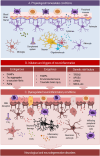The dual nature of neuroinflammation in networked brain
- PMID: 40909282
- PMCID: PMC12404926
- DOI: 10.3389/fimmu.2025.1659947
The dual nature of neuroinflammation in networked brain
Abstract
Neuroinflammation is a dynamic, context-sensitive process that plays essential roles in brain development, maintenance, and response to injury. It reflects a finely balanced neuroimmune state-facilitating repair and adaptation under homeostatic conditions, while also contributing to dysfunction when dysregulated or chronically activated. In this mini-review, we examine the cellular and molecular mechanisms underlying neuroinflammatory responses, focusing on the roles of microglia and astrocytes, their bidirectional communication with neurons, and their interaction with peripheral immune signals. We describe how various stimuli-including aging, protein aggregates, and cellular stress-modulate glial function and shift immune activity toward protective or deleterious outcomes. Special attention is given to endogenous regulatory pathways, including cytokine signaling, receptor-mediated crosstalk, and immunometabolic cues that determine the resolution or persistence of inflammation. We further discuss shared and disease-specific features of neuroinflammation across neurological disorders, offering a systems-level perspective on how immune activity contributes to neural resilience or degeneration. This integrated view aims to inform future studies on neuroimmune dynamics in health and disease.
Keywords: CNS; astrocytes; brain; microglia; neuroimmune interactions; neuroinflammation; neurological disorders; neurons.
Copyright © 2025 Müller, Di Benedetto and Müller.
Conflict of interest statement
The authors declare that the research was conducted in the absence of any commercial or financial relationships that could be construed as a potential conflict of interest.
Figures


Similar articles
-
Crosstalk between peripheral inflammation and brain: Focus on the responses of microglia and astrocytes to peripheral challenge.Neurochem Int. 2024 Nov;180:105872. doi: 10.1016/j.neuint.2024.105872. Epub 2024 Oct 1. Neurochem Int. 2024. PMID: 39362496 Review.
-
Vitamin D as a Modulator of Neuroinflammation: Implications for Brain Health.Curr Pharm Des. 2024;30(5):323-332. doi: 10.2174/0113816128281314231219113942. Curr Pharm Des. 2024. PMID: 38303529 Review.
-
Neuronal guidance signaling in neurodegenerative diseases: Key regulators that function at neuron-glia and neuroimmune interfaces.Neural Regen Res. 2026 Feb 1;21(2):612-635. doi: 10.4103/NRR.NRR-D-24-01330. Epub 2025 Feb 24. Neural Regen Res. 2026. PMID: 39995079 Free PMC article.
-
Brain incoming call from glia during neuroinflammation: Roles of extracellular vesicles.Neurobiol Dis. 2024 Oct 15;201:106663. doi: 10.1016/j.nbd.2024.106663. Epub 2024 Sep 7. Neurobiol Dis. 2024. PMID: 39251030 Review.
-
Arterial Baroreflex Dysfunction Promotes Neuroinflammation by Activating the Platelet CD40L/Nuclear Factor Kappa B Signaling Pathway in Microglia and Astrocytes.Neurochem Res. 2023 Jun;48(6):1691-1706. doi: 10.1007/s11064-022-03852-1. Epub 2023 Jan 2. Neurochem Res. 2023. PMID: 36592325 Free PMC article.
References
Publication types
MeSH terms
LinkOut - more resources
Full Text Sources

